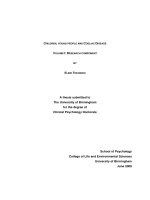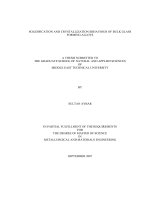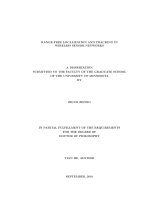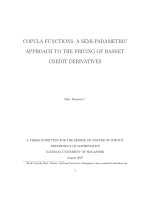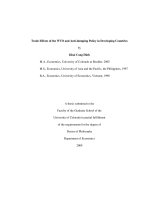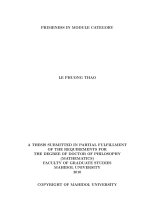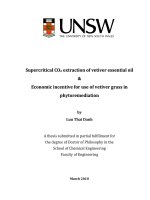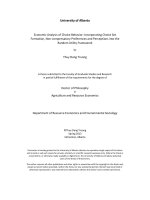A dissertation thesis submitted to the faculty at the University of North Carolina at Chapel Hill in partial fulfillment of the requirements for the degree of Doctor of Philosophy in the Departmentof History.
Bạn đang xem bản rút gọn của tài liệu. Xem và tải ngay bản đầy đủ của tài liệu tại đây (10.24 MB, 177 trang )
ACCOUNTING AND AUDITING IN ROMAN SOCIETY
Lance Elliot LaGroue
A dissertation thesis submitted to the faculty at the University of North Carolina at Chapel Hill in
partial fulfillment of the requirements for the degree of Doctor of Philosophy in the Department
of History.
Chapel Hill
2014
Approved by:
Richard Talbert
Fred Naiden
Howard Aldrich
Terrence McIntosh
© 2014
Lance Elliot LaGroue
ALL RIGHTS RESERVED
II
ABSTRACT
Lance LaGroue: Accounting and Auditing in Roman Society
(Under the direction of Richard Talbert)
This dissertation approaches its topic from the pathbreaking dual perspective of a historian and of
an accountant. It contributes to our understanding of Roman accounting in several notable ways.
The style and approach of Roman documents are now categorized to reflect differing levels of
complexity and sophistication. With the aid of this delineation, and by comparison with the
practices of various other premodern societies, we can now more readily appreciate the distinct
attributes present at each level in Roman accounting practices. Additionally, due to the greater
accessibility of Roman accounting documents in recent years – in particular, through John
Matthews’ work on the Journey of Theophanes, Dominic Rathbone’s study of the Heroninos
archive, and the reading of the Vindolanda tablets -- it becomes easier to appreciate such
differences among the few larger caches of accounting documents. Moreover, the dissertation
seeks to distinguish varying grades of accountant. Above all, it emphasizes the need to separate
the functions of accounting and auditing, and to gauge the essential characteristics and roles of
both. In both regards, it is claimed, the Roman method showed competency.
The dissertation further shows how economic and accounting theory has influenced
perceptions about Roman accounting practices. In particular, double-entry accounting has been
III
overvalued in accounting theory. Early 20th century works by Werner Sombart and Max Weber
heavily influenced historians of Rome. Typically, they accepted that the Romans’ failure to
develop double-entry accounting served as a structural flaw which deprived them of the impetus
for economic rationalism and profit-seeking behavior. Roman historians, however, have not kept
abreast of advances in accounting theory. Today, its practitioners reject the arguments upon
which Roman historians have relied, opting to emphasize instead the worth the contributions
made by the accountants and managers of accounting data themselves, which have never been
adequately assessed in the Roman context.
Altogether, the dissertation taps an enlarged body of ancient testimony (still pitifully
small, nonetheless) together with scholarship in two disciplines that had lost touch with one
another, in order to place our appreciation of accounting and auditing in Roman society on a
fresh, more realistic footing.
IV
ACKNOWLEDGEMENTS
It is with the greatest appreciation that I thank my primary advisor Richard Talbert for his
guidance during my graduate school career at the University of North Carolina at Chapel Hill.
Like all good advisors, his structured approach ensured that I became better prepared in all
relevant aspects such as writing prose, translating, incorporating various styles of historical
analysis, and teaching. However, what made him a truly great mentor was his discipline and
honesty. To this day, I have not seen a harder working academic and one so devoted to his
students. Without fail, he would arrive before eight and left after six. An hour was never
wasted, and he ensured that all spare moments went to meeting with students for their
improvement. Those frequent meetings made the greatest difference in my studies, as it was
during them where he provided honest appraisal with a firm route to improvement. The result
was that he instilled in me a work ethic and a desire for self-improvement that I shall always take
with me. Yet, perhaps the most enduring legacy is that I shall always try to emulate his devotion
to students.
I would also like to extend a special thanks to my other advisors. Fred Naiden has been a
constant inspiration. He has never failed to contemplate every possible element when
considering a historical topic, and his willingness to engage with my ideas has been critical to
my development. Howard Aldrich’s sociology classes added a level of depth to my historical
approaches for which I am grateful. Terrence McIntosh’s impressive command of history and
his readiness to challenge my assertions on comparative history has improved my focus. Brett
V
Whalen has been a valued friend, who worked with me to improve my teaching ability, and I
hope to become as accomplished a lecturer as he is. Also, special thanks to Dominic Rathbone,
whose discussions with me on Roman accounting proved invaluable while pursuing this project.
To finish this dissertation has been a test of mental fortitude, which I could not have
carried through without the immense love and support of my family and friends. My parents,
David and Renee, along with my wife Michelle, always filled my reservoir of strength whenever
I stared blankly at a computer screen or reread the same book for the fiftieth time. I would also
like to thank my friends Michael Chen, Alex Ritchie, Adam Russell, and Graeme Ward for
willingly subjecting themselves to my mock presentations and requests to read drafts, or to
provide technical support. I would like to extend a final thank you to Melissa Barden Dowling
for my initial inspiration to pursue ancient history.
I recognize that a dissertation can never be written in isolation. It was only possible with
such wonderful advisors, mentors, family and friends. Thank You.
VI
PREFACE
Accounting and Auditing in Roman Society has proven a challenging project for many
reasons. Initially, when I discussed it with advisors and colleagues, their individual interests
pointed the focus in a maze of different directions. Should the project reflect and catalog all
accounting data and references as it pertains to the Roman economy? Or should it focus
primarily economic theory in the ancient world, using accounting data to assess the degree of
entrepreneurship of Roman merchants and bankers? Or should it give pride of place to exploring
the differences between the Roman government and army’s uses of accounting versus the private
sphere? Equally, what weight should it give to the social aspects of accounting, the ways in
which the Romans valued and used accounting? To what degree should it seek to engage with
accounting in other premodern societies for comparison?
My first experience was to try as far as possible to incorporate many of these elements. I
sought to trace an individual Roman’s path through the process of accounting: who were the
accountants, how much training did they receive, how much time did they spend on the job, how
long did it take for them to compose documents, how varied were these documents, and what
were their possible uses? The problem rapidly emerged, however, that there was not enough
data to make meaningful assessments. The surviving material about education, career paths,
training, time of composition, approach to documents, notions of standard format and more, was
limited or even non-existent.
VII
After prolonged experiment, it seemed the best compromise to discuss the surviving
material not so much as a historian, but more as an accountant. Drawing on my training in that
discipline, my concern became how accountants would approach the material, especially if they
were to view it from the perspective of an audit. When accountants today view their data, they
look for functionality and effectiveness. They ask whether their accounting documents are doing
what they were designed to do: track inventory accurately and effectively; create an accessible
format; offer speed of understanding with numeric data; provide cash flow analysis and calculate
profitability. From this perspective, my contention is that the Romans can be seen to have had a
fully functional accounting method. Admittedly, several weaknesses were present and I discuss
them, but the method did allow the Romans to achieve the core roles and functions of
accounting. Moreover, the one cultural area where their accounting material prominently
featured was in the legal setting. Accounting ledgers and data were critical records which were
clearly relied upon. Accounting was needed in banking and wills, and its perceived value alone
could prove the innocence or guilt of an individual. These uses underscore the functionality of
Romans’ accounting documents in their society. I draw upon our understanding of accounting in
a limited, but varying, range of other premodern societies in order to reinforce this claim.
This dissertation contributes to our understanding of Roman accounting in several
notable ways. The style and approach of Roman documents are now categorized to reflect
differing levels of complexity and sophistication. With the aid of this delineation, we can now
more readily appreciate the distinct attributes present at each level in Roman accounting
practices. Additionally, due to the greater accessibility of accounting documents in recent years
– in particular, through John Matthews’ work on the Journey of Theophanes, Dominic
Rathbone’s study of the Heroninos archive, and the reading of the Vindolanda tablets -- it
VIII
becomes easier to appreciate such differences among the few larger caches of accounting
documents. Moreover, the dissertation seeks to distinguish varying grades of accountant. Above
all, it emphasizes the need to separate the functions of accounting and auditing, and to gauge the
essential characteristics and roles of both. In both regards, the Roman method showed
competency.
Finally, the dissertation shows how economic and accounting theory has influenced
perceptions about Roman accounting practices. In particular, double-entry accounting has been
overvalued in accounting theory. Early 20th century works by Werner Sombart and Max Weber
heavily influenced historians of Rome. Typically, they accepted that the Romans’ failure to
develop double-entry accounting served as a structural flaw which deprived them of the impetus
for economic rationalism and profit-seeking behavior. Roman historians, understandably
enough, did not keep abreast of advances in accounting theory. Today, its practitioners reject the
arguments upon which the historians have relied, opting to emphasize instead the worth the
contributions made by the accountants and managers of accounting data themselves, which have
never been adequately assessed in the Roman context.
In short, this dissertation taps an enlarged body of ancient testimony (albeit still pitifully
small) together with scholarship in two disciplines that had lost touch with one another, in order
to place our appreciation of accounting and auditing in Roman society on a fresh, more realistic
footing.
IX
TABLE OF CONTENTS
INTRODUCTION………………………………………………………………………………...1
CHAPTER 1: The Transformative Power of Accounting………………………………………...5
CHAPTER 2: ‘Sophisticated’ Roman Accounting Example……………………………….……31
Part 2: Accounting Documents from the Appianus Estate………………………………38
CHAPTER 3: ‘Basic’ Roman Accounting…………………………...………………………….58
CHAPTER 4: Pre-Modern Accounting and Rome Compared…………………………………..78
CHAPTER 5: Accounting Culture and the Digest of Justinian………………………………….94
Part 2: The Digest of Justinian…………………………………………………………...98
CHAPTER 6: Accounting Culture in Cicero’s Court Cases…………………………...………114
CHAPTER 7: Roman Affinity for Accounting……………………………………………...…126
CHAPTER 8: The Roman Auditor……………………………………….....………………….138
CONCLUSION……………………………………………...………………………………….157
BIBLIOGRAPHY……………...……………………………………………………………….163
X
Introduction
The traditional view of ancient Roman accounting (200 BCE- 400 CE) over the past
hundred years has been that it was a hindrance to economic development and prosperity rather
than an aid. This dissertation aims to correct this negative interpretation of Roman accounting
and to suggest that it was more than sufficient for Roman accounting challenges. The greatest
challenge to understanding Roman accounting is the general lack of evidence in both references
and actual documents. However, existing documents and references are sufficient to establish an
upper and lower range of complexity in the types of accounting formats the Romans utilized.
At the upper range, the Romans practiced a “sophisticated” style of accounting, which
included monetizing assets (recording the value of an item in monetary terms), intricate
organization, and profitability assessments. Although the evidence for such usage is very
limited, its existence suggests that when the Romans desired to use more advanced accounting
techniques, they could. The lower range of Roman accounting may be termed “basic”. At this
level, it was an inefficient system. The primary reason for the inefficiency was the lack of
Arabic numerals (0,1,2,3,4,5,6,7,8,9) that help to make well-sorted accounting columns.
Additionally, there was the often rudimentary literacy level of the slaves or freedmen tasked with
preparing the documents. Yet, it should be stated that the Roman system was still completely
functional in conveying numeric information. Further, limiting the focus of study in Roman
accounting to surviving documents and comparing them with formats such as double-entry
accounting, as previously done by Roman historians, overlooks some of the critical advantages
1
in basic Roman accounting, such as the ease of production and understanding (simple documents
are easy to read).
Finally, perhaps the most overlooked aspect that transcended both the “sophisticated” and
“basic” styles of accounting was a favorable Roman cultural disposition toward
accounting. There was a Roman willingness for creativity, understanding, and engaging with
accounting documents that afforded them a certain power to overcome inefficiencies in format.
This energy should not be underestimated.
In order to make the argument that the Romans were competent accountants with a
satisfactory system for the maintenance of a large empire, this dissertation is split into two
halves. The first half focuses on the Roman accounting system, while the second reviews the
cultural infrastructure that helped overcome certain weaknesses. The first half, devoted to
understanding Roman accounts, is divided into four chapters. The first chapter aims to frame the
relative importance of accounting and its impact on Roman historians, especially for those less
familiar with the subject matter and its historical importance. Specifically, it provides the
historiography on how accounting has traditionally been viewed by Roman historians.
The second and third chapters are devoted to detailing the sophisticated and basic
systems of accounting. Chapter two’s accounting example emphasizes the importance of
Dominic Rathbone’s work on the Heroninos Archive, which examines accounting documents
from 3rd-century Egypt. The primary purpose for this inclusion is to highlight how the
accounting documents facilitated organization and profitability assessments of a multitude of
farms with a series of monthly reports.
2
The third chapter illustrates the basic system of Roman accounting. It provides several
examples of relatively simple accounting documents that are easily recognizable as disbursement
sheets or inventory listings, which were typically prepared by slaves or freedmen. The main
structural weakness apparent in these documents is the lack of Arabic numerals that affected
Roman accounting.
The fourth chapter is comparative. It presents evidence from other pre-modern cultures
such as Egypt, Sumer, early Islamic societies, and medieval Europe to help identify underlying
strengths and weaknesses within Roman accounting practices. It also discusses the unique way
in which labor was divided by class. Namely, this chapter shows how, in different societies,
accounting could be performed by the less erudite classes (slaves and freedmen) or specialized
professionals (the priestly class, merchants, or monks), according to their valuation of quanity
over quality and vice versa.
The second half of the dissertation transitions into a social argument that Roman
accounting culture compensated for format weaknesses. The overarching cultural argument is
comprised of three components. The first is prevalence. Inextricably woven into the fabric of
Roman society, Roman accounting presents a recurrent thread, touching such diverse elements as
estate management, personal correspondence, and poetry. The second component posits that
there existed a basic expectation to maintain records whether in a household, business, or
governmental setting. The final component is a surprising affinity for accounting, evinced by
references to Romans actually enjoying aspects of accounting.
The second half, like the first, is divided into four chapters (chapters 5-8). Similarly, the
first three chapters of the second half focus on Roman accounting’s cultural prevalence, while
3
the fourth chapter provides a cultural comparison of accounting with pre-modern Great
Britain. Each of the chapters will touch upon the three aspects of prevalence, expectation, and
affinity rather than treating each component in isolation. For instance, chapter five is devoted to
the Digest of Justinian, chapter six highlights evidence from Cicero’s law cases, and chapter
seven presents a variety of literary evidence. This final comparative chapter develops the
concepts of what it means to be a good accountant, with a specific focus on auditing. The
overarching aim of this dissertation is straightforward. The goal is not to prove that the Romans
were exceptional at accounting, but that they were quite competent with a fully functional system
that did not diminish economic opportunities or their ability to maintain their empire.
4
Chapter 1: The Transformative Power of Accounting
Any historical review of a civilization’s accounting system encounters a series of
challenges. Namely, how exactly does one interpret the extent of accounting’s importance to an
individual civilization? Was accounting more important to a large empire such as that of the
Romans, or was it more vital to a small, mercantile city-state such as that of the Renaissance
Venetians? Or, do ‘importance’ and ‘value’ even matter to a society once its accounting needs
are fulfilled? In that capacity, is it better to ignore direct historical comparisons and simply
consider accounting as a societal tool such as a bowl or spoon — though structural design has
changed little over the centuries, as long as the needs are met, sophistication matters little? Or,
should accounting be considered as consistently altering the trajectory of world history as
firearms have done? Specifically, should accounting be considered a device that, with each
successive development, such as the transition from smooth bore guns in the 18th century to
rifling in the 19th century, clearly altered the development of civilization?
As noted above, the approach and perspective to accounting are of immense importance.
The point of raising such issues at the onset of a discussion of Roman accounting is to
acknowledge that accounting occupies a unique sphere. It is exceedingly important because
without accounting documents, a civilization simply cannot exist beyond an extremely basic
level. People and societies would not be able to plan for future needs, maintain their finances, or
5
consider the optimization of supplies. Yet it is hard to define the extent to which accounting’s
transformative power creates a ‘successful’ civilization. The question of transformative power
has been the central feature of historical accounting studies, and one that has exerted the greatest
influence on the study of Roman accounting. Moreover, the most traditional view of
accounting’s historical influence stems from the late 19th to early 20th century through German
sociologists Werner Sombart and Max Weber. Most Roman historians tend to have some
familiarity with Weber due to his impact on sociology, but there is much less familiarity with
Sombart. Both men were part of the historical trend of the ‘scientification’ of the liberal arts that
dominated social sciences from the 1880s to 1920s in Germany. These scholars invested
considerable energy into ‘mathematically testing’ much of the political philosophy originated by
mid- to late-19th century academics including Georg Hegel, Louis Blanc, and Karl Marx. One of
their key goals was to analyze the driving forces of capitalism. For Sombart, a large element of
capitalism’s success was the advent of double-entry accounting, while for Weber it was the
rational-legal bureaucracy.
Sombart’s 1902 six-volume work, Der Moderne Kapitalismus, arguably reflects the
single most important moment in the accounting studies. In his work, he proposed that doubleentry accounting in the late Middle Ages significantly aided the development of capitalism. 1
Despite the fact that his discussion of accounting was limited to only six pages, its influence
cannot be underestimated.
1
Double-entry accounting is a standard accounting method that involves each transaction being recorded in at least
two accounts, resulting in a debit to one or more accounts and a credit to one or more accounts. Double-entry
accounting provides a method for quickly checking accuracy, because the sum of all accounts with debit balances
should equal the sum of all credit balance accounts.The purpose and goal of double-entry bookkeeping are to enter
financial transaction records so that when financial statements and reports are run, the company's assets are equal to
its liabilities plus owners' equity (net worth). This formula is expressed in accounting terms as:
Assets = Liabilities + Owners' Equity (Net Worth).
6
To demonstrate the high degree of praise Sombart bestowed upon double-entry, the
following are generally considered the points that accounting historians most often cite from
Sombart:2
(1) “Double-entry bookkeeping was born out of the same spirit as the systems of Galileo
and Newton, as the theories of modern physics and chemistry.”
(2) “One will be able without a great deal of acumen to detect in double-entry bookkeeping, in immature form, the ideas of gravitation, of the circulation of the blood, of
the conservation of energy as well as other ideas which have so very much fertilized
insight into nature.”
(3) “Indeed double-entry bookkeeping can be contemplated not without awe and
admiration as one of the most artistically arranged structures produced by the
admirably rich formative capacity of the European human spirit.”
After Sombart’s publication, for roughly seventy years, nearly all successive accounting
studies followed his view, extolling lavish praise on double-entry accounting. Among the most
noteworthy studies are H.M. Robertson’s 1939 Aspects on the Rise of Economic Individualism,
B.S. Yamey’s 1964 Accounting and the Rise of Capitalism, and J.O. Winjum’s 1972 The Role of
Accounting in the Economic Development of England. Additionally, the importance of doubleentry bookkeeping was consolidated in the 1930s by other indirect means. In 1936, John
Maynard Keynes wrote his landmark book,The General Theory of Employment, Interest, and
Payment, where he created his calculation that Y (Aggregate Output) = C (Consumption) + I
(Investment). Most economic students know this formula today as “Keynesian economics”. The
underlying idea is that if you could calculate how much consumption or ‘demand’ was present in
a community, then government could provide investment to increase overall output, thereby
2
Lister 1985, 229-231.
7
increasing overall employment.3 However, the underlying basis for calculating each individual
component of the formula utilized double-entry accounting.4 Similarly, Simon Kuznet’s
development of gross domestic product as a measure of national economic output in the 1930s
rested on calculations done by double-entry accounting.5 Finally, by the early 20th century, all
accounting done by certified public accountants (CPAs) was performed in double-entry.
Visually, publicly, and theoretically, by the mid-20th century, double-entry accounting had
become the dominant form of accounting and was considered a transformative driver of
capitalism.
Similarly, Max Weber’s ideas on bureaucracy influenced the study of Roman
accounting.6 His 1922 book, Economy and Society, defined the ideal bureaucracy, or as he
called it the rational-legal bureaucracy. Although his work incorporates many components,
three of the key elements for the more successful model of bureaucracy included specialized
education for technical positions, regular opportunity for advancements within the organization,
and a merit-based promotion system.7 Although there are some exceptions, generally Roman
3
The formula forms the basis of “Keynesian economics,” advocating government intervention in the marketplace in
times of recession to stimulate weak demand.
4
Gleeson-White 2011, 179.
5
Gleeson-White 2011, 180-182.
6
Part of Max Weber’s creation of the ideal bureaucracy consisted of a couple of bases. The first served as a way to
think about creating efficiency and best practices in a world that was becoming increasingly centralized with larger
corporations and factories. The second was to provide historical reasoning as to why Northern Europe had eclipsed
the Mediterranean and Southern Europe in dominance from the 17 th century through the early 20th century.
7
The following are two of the more relevant and instructive passages from Max Weber’s Economy and Society. Pg.
975:“Bureaucratization offers above all the optimum possibility for carrying through the principle of specializing
administrative functions according to purely objective considerations. Individuals’ performances are allocated to
functionaries who have specialized training and whose constant practice increases their expertise. ‘Objective’
discharge of business primarily means a discharge of business according to calculable rules and ‘without regards to
persons’.” Pg. 973:“The strictly military character of the magistrates’ powers - a characteristic of the Roman polity
unknown to any other people - made up for the lack of bureaucratic apparatus with its technical efficiency, its
precision and unity of administrative functions, especially outside the city limits.” Weber 1978.
8
bureaucrats lacked all of these critical components. More importantly, the higher-ranking
bureaucrats or members of society who performed accounting tasks, such as procurators or
governors, seem particularly ill-equipped when viewed against Weberian bureaucratic
measurements.
Most Roman historians have adopted Weber’s key points about the definition of an
efficient bureaucracy, the result being the generalization that Roman bureaucrats are deemed
quite inefficient or ‘amateur’. For instance, Brian Campbell states that “in the context of Roman
society ideas of specialization and professionalism are largely anachronistic…senatorial career
was built around traditional Roman conceptions of office holding of the state. The men who
governed the great consular provinces were, in general, all round amateurs”.8 G.P. Burton
declared: “Overall it is suggested that the clearest and most consistent feature of the proconsular
government is its weakness.”9 Peter Brunt inverts Burton’s comments when he stated: “Hardly
any class of men rendered more important services to the Roman state than those charged with
local government,” thereby imply that little work was done by the appointed officials from Rome
directly.10
8
Campbell 1975, 25.
9
Burton 1971, vii.
10
Brunt 1990, 267 and 270. Also see Saller 1982, 79: “The position taken on this question has broad
implications for the historian's conception of Roman imperial government. Modern 'rational-legal' bureaucracies
are characterized in part by the objective of appointing and promoting in accordance with the impersonal criteria of
seniority and merit. Though it may not be achieved, the objective is at least pursued through bureaucratic regulations and
institutions (e.g., the Civil Service Examination). By contrast, in a patrimonial government there is little
regulation: appointments depend on the discretion of the ruler who is apt to select on the basis of personal loyalty and
friendship. Augustus' administration, made up of his household and friends, can be characterized as 'patrimonial'. The
question is then: to what extent did appointment and promotion come to be regulated in the following two centuries? In
answering this question, we shall also be offering a partial answer to the more general question of how far Roman
imperial government was 'rationalized' in the Principate.”
9
The cumulative effect of Sombart’s view on double-entry and its relationship to
capitalism and Weber’s rational-legal bureaucracy became a prominent feature of the two direct
studies of Roman accounting in the mid-20th century. The first study was by Gunnar Mickwitz
in his 1937 article, “Economic Rationalism in Graeco-Roman Agriculture,” in which he explored
the use of accounting in economic decision-making regarding agriculture practices in ancient
Greece and Rome.11 The primary ‘case study’ for his examination was the Zeno archives on the
Greek side and the agricultural writers Columella, Varro, and Cato the Elder on the Roman
side.12
From Mickwitz’s perspective, each of these individuals left behind enough evidence,
whether through actual farming records (as was the case with Zeno) or farming manuals (as was
done by the Roman authors), to discern something of accounting habits and decision-making.
Overall, Mickwitz came to the conclusion that profit calculation factored only minimally into
Graeco-Roman agricultural decision-making.13 Indeed, their records indicated no amortization
of capital expenditures, which would have hampered their ability to assess the true cost or impact
of large purchases.14 Accounts for individual items such as vines (grapes for wine) or sheep
11
Mickwitz 1937, 577-589. He suggests that there existed little differentiation between Greek and Roman cultures
in regards to accounting; therefore, he combined his analysis of Greece and Rome to include the period of roughly
400 BCE to 300 CE.
12
The Zeno archives are a large cache of papyri found in early 20th century Egypt. Over 2,000 papyri document
Zeno’s labors, correspondence, and business affairs from the 3 rd century BCE. During this period, he served as
private secretary to Apollonius, who was the finance minister to two different Ptolemaic kings. The three Roman
writers span periods from the 2nd century BCE through the 1st century CE (Cato 234-149 BCE De Agri Cultura,
Varro 116-27 BCE Rerum Rusticarum Libri III, Columella 4-70 CE De Re Rustica). Each man had achieved success
in other various professions, most commonly politics and military service, before spending their later years writing.
Cato and Varro wrote on a variety of subjects, whereas Columella is more obscure, and only his writings on
agriculture have survived.
13
Mickwitz 1937, 586.
14
Mickwitz 1937, 578. “Had Zeno wished to give his master an account of the rate of profit attained he would
necessarily have had to separate capital investment from current expenditure. For instance, he would have to
10
were separated and monetized (recorded in cash value), so it is much harder to calculate which
farm or area was more profitable.15 Finally, recorded expenses were oversimplified to the point
of near negligence in their omissions.16 Mickwitz ultimately demonstrates the accounting
system’s failure to yield any true benefit to economic planning or profit maximization (i.e.,
economic rationalism).
The second study was by G.E.M. de Ste. Croix in 1956, titled, “Greek and Roman
Accounting.”17 His article is part of the collected work, Studies in the History of Accounting,
edited by A.C. Littleton and B.S. Yamey. Its intention was to survey the historical development
of Western accounting practices, with a focus on acknowledging the impact of double-entry
accounting.
De Ste. Croix’s analysis treats Greek, as well as Roman, accounting practices similar to
Mickwitz’s earlier work. However, he divides his analyses into separate Greek and Roman
sections. Indeed, his goal is not to offer direct contrast but rather to reveal the structural
weaknesses of both practices. Furthermore, the article is subdivided into seven sections. The
have recorded the money spent on works for the amelioration of the land or on buildings in separate accounts.
But this seems not to have been done.”
15
Mickwitz 1937, 584: “He [Zeno] says, ii. 5, that when the master visits his farm he should examine the steward's
accounts which consist of money-accounts, grain-accounts, fodder-accounts, oil-accounts, and wine-accounts. This
system seems very familiar to us, and it is, indeed, nothing but a repetition of Zeno’s accounting method. It is now clear
why Cato’s advice as to the purchase of farms was so vague. Owing to the defects of his system of bookkeeping he
was unable to make the necessary plans for increasing the monetary income from a particular farm.”
16
Mickwitz, pg. 587. “On the other hand Varro, i. 7, 10, takes into account the expenses incurred by vinegrowing, but does this in a perfectly vague way: vineam sunt qui putent sumptu fructum devorare. The same might be
said of his description, i. 16, of different ways in which farming might be influenced by geographical position. If
we turn to Pliny the Elder, we find the same remarkable neglect of expenses that we find in Varro’s writings.
He tells us, xiv. 4, 49-50, the story of Remmius Palaemon, who bought a farm and in eight years was able to sell
the crop of his vineyard for nearly the same amount that he had given for the whole farm. Pliny, however, entirely
ignores the costs incurred by what was probably a very expensive experiment in model farming.”
17
De Ste. Croix 1956, 14-74. It is worth noting that Mickwitz’s initial study on ancient accounting was often
overlooked by scholars, and most consider de Ste. Croix as the initial survey of ancient accounting methods.
Further, de Ste. Croix even suggests on page 37 of his 1956 article that Mickowitz was overlooked: “The neglect of
this important paper, especially by historians of accounting, maybe due partly to its rather unfortunate title.”
11
first two discuss the nature of Roman and Greek sources; sections three and four provide an
overview of classical and Hellenistic accounting; section five analyzes Roman material; and the
final two sections analyze key hindrances to Rome’s development of double-entry accounting.18
De Ste. Croix argues that Roman accounting systems and practices reveal a notable lack
of advancement or sophistication. He asserts that the Romans failed in any serious attempt to
develop a double-entry accounting system. To understand why he, in addition to Sombart,
thought this was critical, it is useful to review Littleton and Yamey’s introduction:19
“Double Entry has three main advantages over the earlier methods of record keeping.
First, the records are more comprehensive and orderly; second, the duality of entries provides a
convenient check on the accuracy or completeness of the ledger; third, the ledger includes,
among personal, real and nominal accounts in an integrated whole, the materials for developing,
as part of the system, statements of profit-and-loss and of capital, assets, and liabilities.”20
The following passage indicates de Ste. Croix’s opinion of the extent of double-entry’s
importance.21
“The question has often been asked in modern times how far the Greeks and Romans
developed systematic book-keeping, and in particular whether they employed double entry. It
will help to put the subject-matter of this essay in better perspective if I make it clear from the
18
Sections are divided as follows: I. The Sources (pgs. 15-19), II. The Absences of “Bilateral Form” (pgs. 19-21),
III. The Classical Greek Period (pgs.21-31), IV. The Hellenistic Period (pgs. 31-33), V. Roman Accounting (33-50),
VI. Greek and Roman Numerals (pgs. 50-61), and VII. Arabic Numerals and the Rise of Modern Accounting (pgs.
61-74).
19
Littleton and Yamey 1956.
20
Littleton and Yamey 1956, 9. For further elaboration, Yamey states: “Double entry is basically a classifying
device or technique of considerable efficacy, adaptability and versatility. As such, the system itself does not
determine what transactions or items should fall within its sway. The system remains intact, for example, in its not
mentioning whether or not unrealized increases or decreases in the value of assets are recorded in the ledger. Again,
the system does not determine how a particular item should be classified: for instance, Yamey and Littleton do not
address whether a particular debit should be transferred as a negative item to the profit-and-loss account, or instead,
be retained as an ‘asset’ in the balance sheet. As a classifying technique, the system of double entry has little, if any,
influence on profit calculations and balance sheet valuations, issues central to the modern accountant; in a sense, all
the system does in this field is to ensure consistency between the profit calculation and net changes in recorded asset
values.”
21
De Ste. Croix, 14.
12
start that the Greeks and Romans, far from reaching the advanced stage of accounting at which
double entry becomes possible, thought, and kept their books, mainly in terms of receipts and
expenditure rather than debit and credit; and furthermore that they never even got as far as the
habitual separation of what we should call debit and credit entries by inserting them in two
separate columns, let alone on opposite pages of an account. That the Romans, at any rate,
regularly wrote debit and credit entries on opposite pages of their accounts has been asserted
again and again, without ever (as far as I know) being contradicted; but the whole conception is
false, as I shall show. Ancient accounts are not disposed in double columns: they are not even
placed precisely in single columns. If, as sometimes happens, the figures are written
approximately underneath each other, this is done, as we shall see, not in order to assist
computation but merely to give a neater appearance, or to make it easier and less fatiguing to
follow the account and trace individual items within it. The Greeks and Romans did develop
some quite advanced institutions in the fields of property law and commercial practice; but their
bookkeeping, minutely detailed as it often was, remained rudimentary in method and never grew
into an integrated double-entry complex, with interlocking accounts, or even into a unified
single-entry system.”
To be sure, de Ste. Croix acknowledges that the Romans proved adept at keeping track of
receipts and proceeds, and that they valued accounting sources in legal or court affairs.22 Yet,
despite the resources available in terms of the monetized economy and ability for trade, they did
not advance towards a more modern accounting system. It is perhaps this aspect that scholars of
both accounting history and Roman society find puzzling.
The most recent work by a Roman historian in reviewing Roman accounting practices is
the 1980 book, Der Codex accepti et expensi im romischen Recht: Ein Beitrag zur Lehre von der
Litteralobligation, by Ralf Michael Thilo. The study is uniquely different from those of both
Mickwitz and De Ste. Croix. Whereas they sought agreement with Sombart’s belief about
accounting’s transformative power and Weber’s view that lack of double-entry acted as a barrier,
Thilo sought to review the Roman language used in accounting practices. However, one critical
aspect he confirmed was that the language of accounting did not seem to indicate a use or
development of double-entry.
22
De Ste. Croix, 17.
13
The great problem for Roman economic academics is their general lack of knowledge
about how accounting theory has changed since the 1970s. Sombart in particular went
unchallenged by a Roman historian until the early 1990s. However, since the 1970s, both
Sombart and Weber have consistently been challenged by accounting historians, with the result
that double-entry is now considered the most efficient means of accounting, but not so impactful
force as to suggest it caused the development of capitalism. It is important to suggest that most
Roman historians still remain largely unfamiliar with this shift in view. For Roman accounting
studies the following consequences due to the primacy placed on Sombart and Weber should be
understood:
(1) Double-entry accounting: The majority of Roman historians who have discussed
accounting directly or indirectly (such as in economic analyses) place too high
significance on double-entry accounting. They become preoccupied with discovering
whether it was utilized by the Romans, because it was considered the marker for a
sophisticated or unsophisticated accounting system.
(2) Double-entry led to capitalism: Roman historians have generally adopted the view
(either consciously or subconsciously) that double-entry is a requisite precursor to
capitalism. This is incorrect. Rather, double-entry is an efficient tool for individuals and
firms in profit-oriented thinking, but its usage is not a good marker for detecting a
society’s level of capitalistic orientation.
(3) Document focus: Due to Sombart, the prevailing focus for 70 years was upon the
accounting documents rather than the bookkeepers and accountants who were creating
and utilizing such documents. Their role has been undervalued in analyses by Roman
historians who adopted Sombart’s valuation of double-entry. Similarly problematic is the
fact that accounting historians are generally too unfamiliar with antiquity to make a
strong assessment about the Roman accountants themselves, and so must limit their
studies to the documents and comments offered by historians unfamiliar with accounting.
(4) Amateur bureaucrats: By Weber’s definition of a rational-legal bureaucracy, Roman
bureaucrats who performed accounting duties were amateurs rather than trained
professionals. Although in many ways accurate, such a general view prohibits an
acknowledgement of accounting successes within Roman culture.
14
The problem for Roman historians is that they have largely not recognized reactions
against Sombart and Weber since the 1970s. The current trend has been to diminish the impact
of double-entry accounting and its capitalistic transformative power have diminished for three
reasons: (1) historical implementation, (2) the philosophy of taxation and profit orientation, and
(3) comparison of accounting practices, especially in non-Western societies.
Sombart erred in his original analysis by overlooking the general implementation of
double-entry accounting. In fact, the first double-entry account dates from the 13th to 15th
century in the Italian city-states of Genoa, Florence, and Venice. The first formal textbook
discussing double-entry was published by Luca Pacioli in 1494.23 Even then, although it was
developed in the late Middle Ages and early Renaissance, double-entry’s use was hardly
ubiquitous until well into the onset of the Industrial Revolution in the 19th century. Even in the
18th century, the British maintained a largely split view of which types of accounts to maintain.
For instance, 18th century England saw the publication of four distinct guides on accounting and
estate management. Two of the guides, Charles Snell’s Accompts for Landed Men (1711) and
Edward Laurence’s The Duty and Office of a Land Steward (1731), offered suggestions on the
use of a familiar charge and discharge accounting system, one that is easier to understand and
use for household managers, employees, and servants. Conversely, Thomas Richards’ The
Gentleman’s Auditor (1707) and Roger North’s The Gentleman’s Accomptant (1714) advocated
the use of double-entry due to its advantages in thoroughness.24
Not only did the rift in approaches differ both in terms of advocacy, but it also showed a
split across geographic regions. David Oldroyd and Alisdair Dobie have demonstrated that a
23
Summa de Arithmetica Geometria, proportioni et proportionalita. Published in Venice, 1494.
24
Oldroyd and Dobie 2009, 108-109.
15
